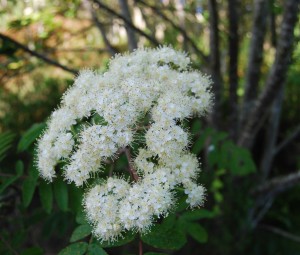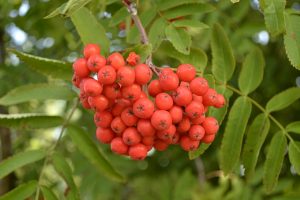Rowan – Sorbus aucuparia (Rosaceae)
Gaelic: caorann
Common Names: Mountain Ash
The rowan is also known as the mountain ash, as its leaves resemble those of ash (Fraxinus excelsior). It is found throughout most of Europe, parts of Asia and northern Africa. It has a slender trunk with smooth gray bark and white lenticels, it can reach up to 15m in height, although in harsher environments it is never more than a low shrub. In spring it is covered in large clusters of small creamy flowers, which lead to the bright orange-scarlet fruits which adorn them in late summer and early autumn. It is tolerant of pollution and poor soils, which has meant it is often used in plantings in urban areas and parks.
The wood is used for a number of purposes including turning and wood-carving, fence posts and broom handles, and the bark can be used for tanning. The berries are bitter until the first frost, which degrades the compounds which cause this, they can then be used to make an astringent jelly, which is a preferred by some as an accompaniment for game.
Rowan has a strong association with magic and was thought to be the most potent of trees to protect from evil. Today rowan is still found growing near stone circles, cairns and houses throughout Scotland. Many items in the house, particularly those that needed protecting from evil e.g. butter churn, and the house and barns would have rowan incorporated in to them.
Location



2 Comments
2 Pingbacks